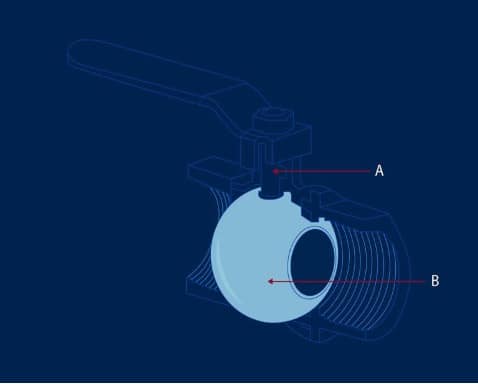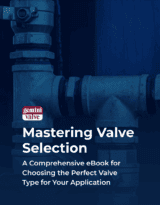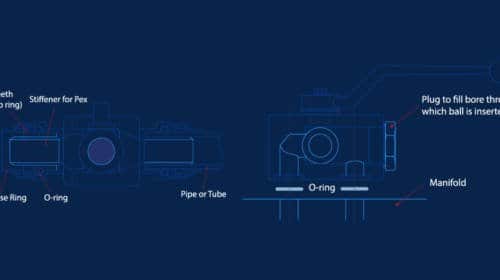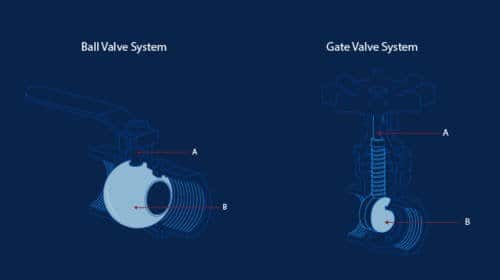Plug Valves vs. Ball Valves: Key Differences & Applications
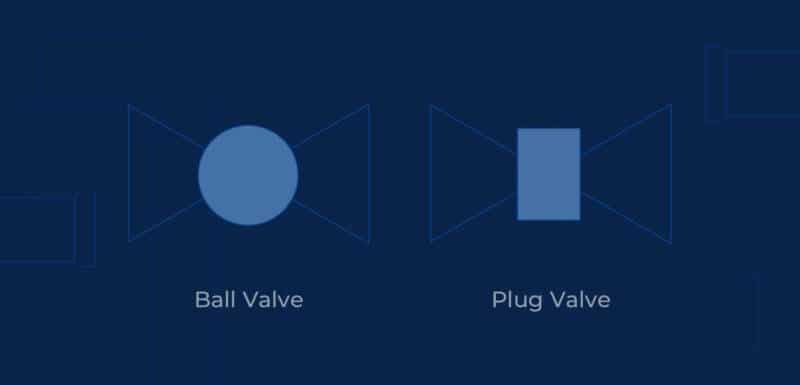
The primary purpose of both plug valves and ball valves is to control the on/off flow of media in a piping system. While they are similar, installing the wrong valve for your application can make it less efficient, and can even cause safety hazards.
When it comes to function and design, there are certain pros and cons to each valve type.
What is a Plug Valve?
Also known as a cock valve or spinning plug valve, a plug valve features a conical, tapered, hollow plug that rotates to allow media to pass through a rectangular passage, or bore. Plug valves are frequently used in compact, low-pressure and mid-to-low-temperature applications, and are not suitable for throttling purposes (flow regulation).
Like ball valves, plug valves are quarter-turn, meaning that their full range of motion is 90 degrees. When the valve is completely closed, the hollow passage through the center is entirely covered, which prevents media from passing through. To allow media to flow through, plug valves should be completely open; forcing them partially open or closed to the flow of media risks damaging the valve.
Plug valves are best used in systems that require fast on/off media control. Though plug valve variety is limited, there are two distinct types of plug valves available:
- Lubricated plug valves: Made of stainless steel or another corrosion-resistant metal, these valves have a lubricant chamber that provides constant lubrication to the plug. This reduces friction, making the entire valve easier to actuate, and protects the plug from corrosion. Lubricated plug valves are often used in larger, high-temperature applications with high torque requirements.
- Non-lubricated plug valves: These valves feature a non-metallic (elastomeric) sleeve installed between the plug and the body of the valve. This sleeve helps reduce friction between the plug and the valve body, but cannot be used in high-temperature applications.
>> Related Reading: Download our Actuator eBook
What is a Ball Valve?
A ball valve is a quarter-turn, on/off valve that relies on a pivoting ball to control the flow of liquid or gas. The ball has a bore (or hole) in it through which media passes, and its position relative to the pipe walls dictates whether the valve is open or closed.
Ball valves are quick-operation and used for sealing and shut-off operations. As such, they are not suitable for throttling purposes — like plug valves, adding this capability would require expensive customization.
Ball valves are favored for their compact, simple design. They are suitable for a range of industrial applications, often used in systems that transport liquid chemicals, natural gas, food and beverages, cooking oils and various slurries.
Plug Valve vs. Ball Valve: Key Differences
Plug valves and ball valves are very similar in function and design, but there are slight differences that make one more suitable than the other for certain applications. See the chart below for a quick reference guide to the key differences.
| Feature | Plug Valve | Ball Valve |
| Design | Conical or cylindrical rotating plug with a bored passage | Spherical disc with a bored passage |
| Size | Smaller than most other types of valves | Compact but scalable |
| Comparative Weight | Heavy at larger sizes | Moderate (lighter than plug valve) |
| Operation | Difficult due to high torque requirements | Easy to operate due to low torque requirements |
| Actuation | Manual and electric (pneumatic is possible, but expensive to install) | Manual, electric, hydraulic, pneumatic |
| Sealing/Shutoff | High (larger sealing surface area; provides tighter seal than ball valve for media less dense than air) | Good (smaller sealing surface area than plug valve)
*Note: New advancements in chemical sealants and seal injections enable ball valves to easily overcome the drawback of lower sealing capabilities. |
| Cost | $$$
(dependent on size & materials) |
$$
(dependent on size & materials) |
| Scalability | Limited | Excellent |
| Maintenance | Plugs can be easily removed and cleaned | Standard ball valves are designed to be replaced, not repaired. 3-piece models are required for serviceability |
| Longevity | Sealing surface of the plug valve is easily worn; high torque, larger surface area exposes valve to more wear & corrosion | Long-lasting in most applications; low torque results in less wear |
| Versatility | Limited; most are full-bore w/ rectangular ports | High; multiple varieties based on structure & function (full bore, standard bore, trunnion, floating, etc.) |
| Customization | Little room for customization | Greater margin for customization |
Regarding this final item, complex customizations will be expensive no matter the type of valve. Upfits like adding anti-friction components or installing an electric or pneumatic actuator will increase the cost (more so for plug valves). Fortunately, there is such a wide array of ball valves on the market that most system engineers will find a ball valve to suit their specific application.
Plug Valve vs. Ball Valve: Applications & Use Cases
Due to their simplicity and relative durability, ball valves and plug valves are both used extensively in a wide range of piping systems.
With a full-port design that enables unrestricted media flow, plug valves are frequently used to transport slurries, including mud and sewage. They also provide bubble-tight shutoff for liquid, gas and vapor media. If fortified, their already-tight shutoff capabilities can offer a leak-tight seal against corrosive media. Their simplicity and anti-corrosion qualities make them exceedingly reliable in applications where quick, tight shutoff is critical.
Ball valves also provide a bubble-tight shut-off in fluid services like air, gas, vapor, hydrocarbon, etc. Favored for high pressure and high temperature systems, ball valves are found in gas lines, crude oil plants, tank farms, oil refineries and automated process applications. Ball valves with the highest pressure ratings can be found in underground and subsea systems. They are also popular in sanitary applications like medical, pharmaceutical, biochemical, brewing and food and beverage processing.
Which Type of Valve is Right For Your Application?
The function and design of plug and ball valves — and the differences between them — are fairly straightforward, but it always helps to speak to an expert who can guide you in the right direction.
In short, if you require an on/off valve for low- to moderate-pressure applications, a plug valve will provide a quick, leak-tight seal. For low- to high-pressure applications (especially those for which keeping torque to a minimum is critical), ball valves are a reliable, easy-to-operate solution. There are exceptions in every case, but familiarizing yourself with their specific qualities and recommended use cases is a good place to start.
The team at Gemini Valve has over 50 years of experience manufacturing and supplying ball valves to a wide range of customers, and can recommend the best type of valve for your use case. We can even custom-design a product to fit your specific requirements — read about a recent customer success story here.
Elevate Your Professional Insight on Valve Selection
Our comprehensive eBook provides a deep understanding of valve types, selection criteria and industry applications. Equip yourself with the best.



